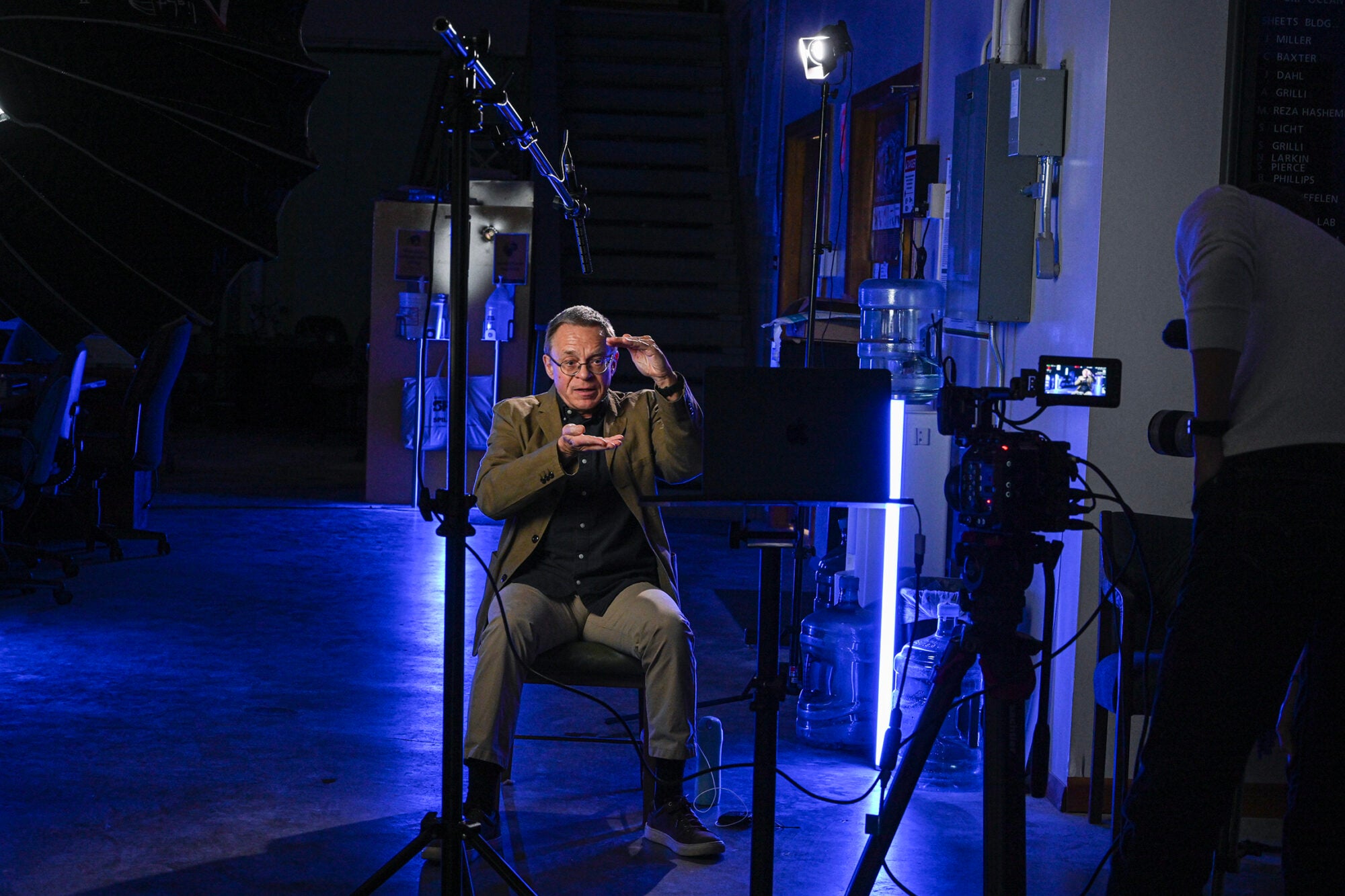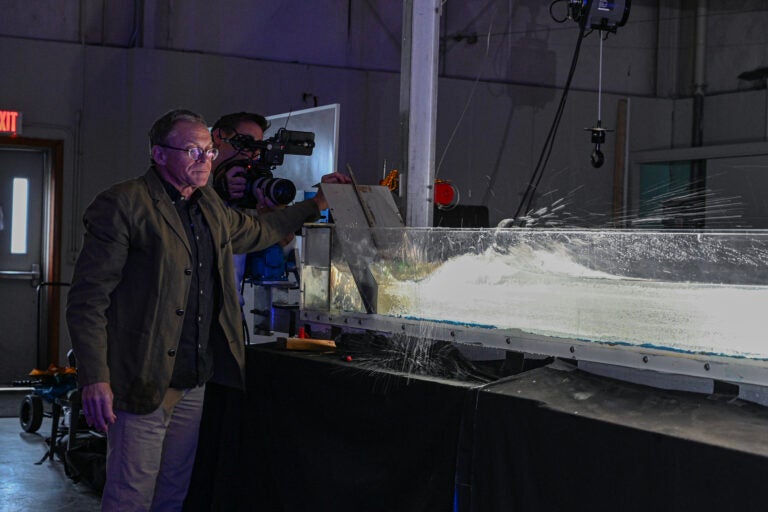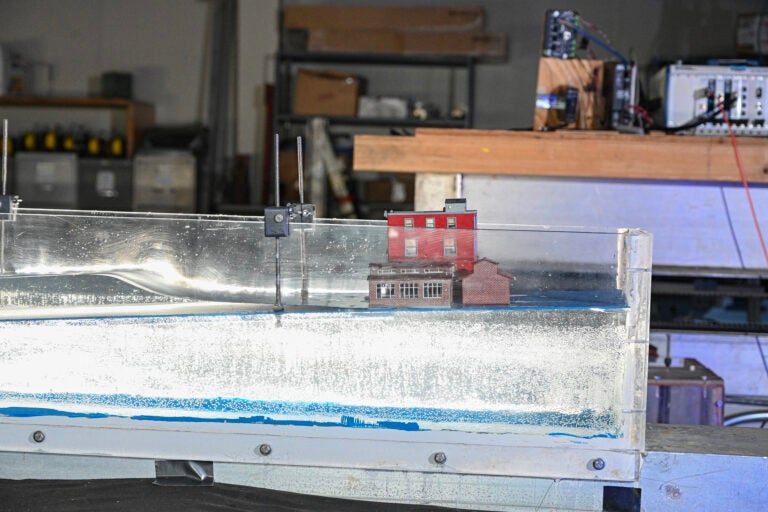Stephan Grilli continues years of work with European scientists
 |
| DISCUSSING THE SCIENCE OF TSUANMIS: Stephan Grilli being interviewed in his lab for a French TV documentary. URI photos by Nora Lewis |
University of Rhode
Island Professor of Ocean Engineering Stephan Grilli has had a keen interest in
the French Riviera for the past 25 years. But his visits have not been about
taking in the yachting scene, the beaches, golf courses or even the Cannes Film
Festival.
Instead, he has spent time in France since 1996 on four
separate sabbaticals collaborating with French, Italian, United Kingdom and
other European scientists to further his research on the threat of tsunamis to
the French Riviera and preventing the loss of life and property. In fact, his
last research trip to the area, from January to July 2022 led to the URI
scientist being interviewed remotely by French journalist Marine Chassang for
CAPATV, France’s largest producer of television news reports and documentaries.
 |
| A TSUNAMI SIMULATION: University of Rhode Island Professor of Ocean Engineering Stephan Grilli simulates the effects of a tsunami in his laboratory for Photographer Edward Bally. |
In February, a cameraman recorded the interview live and
captured video of Grilli demonstrating the effects of tsunamis using the wave
tank in his laboratory at URI’s Narragansett Bay Campus.
The documentary ran June 21 on the French RMC
television channel.
Grilli’s seven-month sabbatical last year, one of four
awarded to him since the mid-1990s to conduct research in the area, was funded
through the Fulbright Distinguished Tocqueville Chair Award, the most
prestigious appointment in the Fulbright Scholar Program. Scholars are expected
to work with host institutions in a spirit that promotes understanding and the
sharing of research findings. His two main partners during this period were
researchers at the University of Toulon and the University of Nice.
 |
| DESTRUCTIVE WAVE: A “tsunami” is about to destroy a small “village” in Professor Stephan Grilli’s wave tank. |
“The Mediterranean area is one of the most seismically
active in the world,” Grilli said, while referencing the Feb. 6 earthquake in
Turkey, the largest in that country since 1939. “They have earthquakes in that
region–Turkey, Greece, and southern Italy–all the time. When those earthquakes
occur on and below the seafloor, they may cause tsunamis. The Mediterranean has
had many damaging tsunamis, the most damaging of which, the largest catastrophe
in modern history, was in the Mesina straits in 1908. We’ve published
extensively on that. It killed 80,000 people.
“The tsunami was produced by a very small earthquake, a
7.2 magnitude,” Grilli said. “We created models that showed it should have
created a tsunami of about 6 or 7 feet, about 2 meters, but 12 meters were
measured on the shore, and so that’s about 40 feet. That’s been a little bit
forgotten.”
Work conducted by his research group and a doctoral
student, Lauren Schambach, showed that there was an underwater landslide
triggered by the earthquake in 1908 on the seafloor of Sicily from the slope of
Mount Etna.
That is why he has been conducting extensive research in
the area of the French Riviera. He doesn’t want people in that region, where
about 2 million people live and which attracts more than 10 million tourists
each year, to forget about the threat.
“My latest research was built around tsunami detection in
the Mediterranean by radar. In fact, I was actually working in France in
2013-14 during a sabbatical supported by the French that focused on the use of
ocean radar for tsunami detection.”
The documentary focuses on the coastal area from Genoa,
Italy, to Marseille, France, much of which is along the French Riviera. Grilli
said the Ligurian faults are located on the seafloor about 20 miles offshore.
“Those faults have been the sites of several earthquakes,
the largest one in 1887,” Grilli said. “It caused a tsunami in the fishing
villages that are now the big cities of Nice and Cannes, which could have
reached 2 to 3 meters in some locations. We have the data. Only about half of
the fault was affected. But now the big question is when is the next portion
going to cause an earthquake and subsequent tsunami?”
Even the expansion of the airport in Nice, which involved
adding tons of sediment to extend a runway into the ocean, caused a tsunami in
1979. The sediment collapsed into the ocean, causing a tsunami that killed two
people. Grilli said.
He and his colleagues have completed models of two
scenarios about what could happen if the Ligurian faults become active again.
They also researched what would happen if a major earthquake occurred on the
coast of Algeria.
“If an earthquake occurred and caused a tsunami, all of
France’s south coast would be affected,” Grilli said.
“It’s a question of preparing,” Grilli said, adding that
the U.S. is a bit more prepared.
Grilli serves on the National Tsunami Hazard Mitigation
Program, which is part of National Oceanographic and Atmospheric
Administration’s National Weather Service.
NOAA provides funding to regional agencies facing the
potential of tsunamis such as the Northeast Emergency Consortium, which
supports Grilli and a colleague at the University of Delaware. The team
conducts research covering the 14 East Coast states from Florida to Maine.
“We have maps that emergency managers can look at to
prepare for tsunamis,” Grilli said. “In France, they are starting to do it.
France, Greece, Italy and Spain created the European Center for Tsunami
Forecasting, which is creating tsunami scenarios and simulations.”
Grilli talked about what it means to him as a researcher
to see governments taking action.
“That’s what you wish for, that what you do is useful to
society, especially something like this that can help save lives. You want to
save lives by informing people. When the 2004 tsunami occurred in Indonesia,
the local people knew about the dangers of a tsunami. And they were aware of
what could happen. But many people were killed because those living in the
resorts were curious, when the water began receding from the coast, they went
looking. A little English girl, who had watched a documentary in school about
tsunamis, ran up and down the beach with her dad telling the people about the
tsunami, and she saved hundreds of people. That English girl’s actions show
that basic knowledge can save lives.”
Grilli said he and his colleagues are doing similar
things on a much larger scale.
“Look at Narragansett (Town) Beach during the summer,
there are 5,000 people there. If you had a bad tsunami off the (continental)
shelf somewhere, the stakes are much higher,” Grilli said.
“In France where the faults are close to the coast, it
might take only 10 to 15 minutes for a tsunami to reach the Riviera, a region
that also has very crowded beaches from May to October. You might feel some
vibrations from an earthquake, then you get on with enjoying your day, and then
you have a major catastrophe.”
EDITOR'S NOTE: Dr. Grilli was my nephew Chris O'Reilly's teacher and mentor from Chris's undergrad days through the completion of his Ph.D. in ocean engineering. Our whole family owes Dr. Grilli a lifelong debt of gratitude. - Will Collette